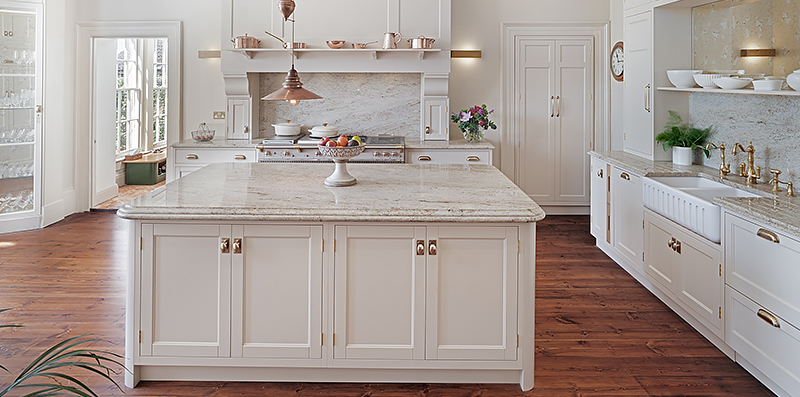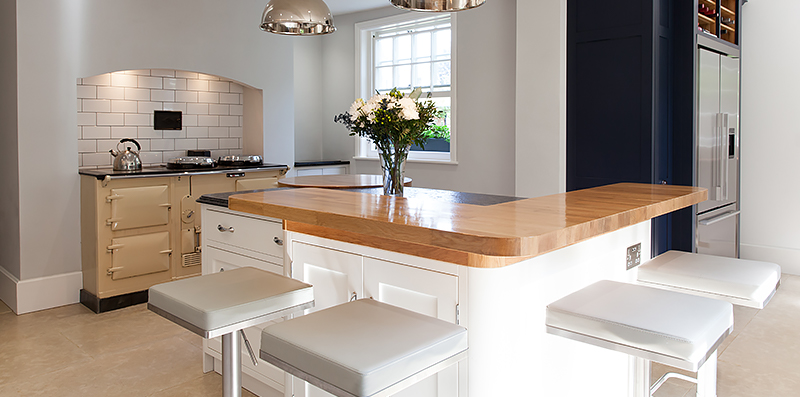
Kitchens with Islands
How Optimise Your Space
Look at how our clients have transformed their kitchens with islands into stunning culinary spaces. In many homes, the kitchen island serves as the centrepiece, a social hub, and the room’s focal point. Achieving the perfect balance is crucial—whether it’s about size, shape, colour, or work surface, finding the right combination will turn your kitchen into a dream space.
But it’s not just about aesthetics. Practicality plays a major role, and it’s often overlooked. Are you an avid cook or a frequent party host? Either way, your island should be more than visually appealing—it must serve a clear purpose. Historically, islands were designed to create a subtle division between the chef and guests, allowing the cooking space to remain a haven for culinary creativity. Therefore, it’s essential to first design your island with your needs and lifestyle. Once that’s perfected, you can think about how it will function for guests.

What is your home lifestyle?
Before looking at more Kitchens with Islands, let’s take a look at you more closely. Your day-to-day life is the key to finding the right balance and purpose for your kitchen island. Do you have a large family? Do you have many social gatherings? Are you an eager cook or chef who needs room to be creative? Is the room solely a kitchen? Perhaps it’s a kitchen/diner? Or even an open-plan studio? Each of these items needs to be considered when determining the purpose of the island. Each aspect – shape, size, and colour – will be defined accordingly.

What will the island mainly be used for?
Designing great kitchens with islands involves considering its primary purpose. Whether it’s for cooking, dining, socialising, or storage, your island should be tailored to meet your specific needs.
If cooking is your main focus, your kitchen island can streamline the process. Ample space is crucial for culinary tasks like chopping, kneading, and prepping ingredients.
For dining, seating becomes a key consideration. Start by deciding how many people you’d like to accommodate and what type of seating works best. Whether it’s box seating, bar stools, circular designs, or even two-tier islands, the options are plentiful.
If your kitchen with an island is the social hub for family and friends, you might want to think about how your island can create separation between you and your guests. Some shapes allow for better hosting while keeping your workspace separate from the social area.
Storage is another important factor, especially if cabinet space is limited elsewhere in the kitchen. Kitchens with islands can provide much-needed storage, but the shape and design will influence how much you can store. If storage is your top priority, you may want to avoid decorative elements like open shelves, opting instead for a more functional design.

Appliances
A growing trend in modern kitchens is to integrate appliances into the kitchen island. This approach frees up space in other parts of the kitchen, creating a more seamless and cohesive design. Sinks, hobs, dishwashers, and even wine coolers are now commonly built into islands, making them multi-functional centres of the kitchen. Many designers suggest that before finalising your kitchen layout, you should first choose the appliances you need. This allows for a more balanced distribution of essential elements and can influence the shape and purpose of your island, ensuring it meets both practical and aesthetic needs.

Shape
Truthfully, kitchens with islands don’t need to be symmetrical. In fact, the design can be as unique as the space itself. Start by establishing the layout of your wall-based cabinetry, sink, and appliances. Once you have a clear picture of those elements, you can begin to determine what storage options and appliances to incorporate into the island.
From there, you can explore various shapes that suit your kitchen’s layout. For instance, rectangular islands tend to harmonise well with the overall symmetry of your kitchen design. In square or compact spaces, a rectangular island can create a more balanced feel, as other shapes may appear out of place. Additionally, a rectangular island often provides ample storage options, with the possibility of including cabinets and drawers. If you’re considering a shelf, you can opt for a design with storage space beneath it and a shelf above.
This shape not only maximises storage but also minimises clutter, making it a practical choice for kitchens of all sizes. Ultimately, the goal is to ensure your kitchen island complements your overall design while serving its intended purpose effectively.

Moving away from tradition, circular and square islands are more popular now than ever before. If you asked many of the top home-based chefs in the world, be it Jamie Oliver or James Martin, they would all agree that a circular island is good for moving around the kitchen. If you like scooting around your kitchen and balancing an array of different chores, then a circular island may suit you. Having a circular island enables you to have a comfortable seating area while separating you from your guests during cooking or entertaining. The only drawback may be its lack of ability to host appliances on the circular section. A small circular island could not typically hold appliances that other designs may allow.

An L-shaped island offers incredible flexibility, making it a fantastic choice for kitchens with islands. With its design allowing for multiple entry points—often up to six—this island type lets everyone move around freely, whether you’re in a morning rush or hosting a dinner party. It helps prevent those awkward moments of bumping into each other and reaching across the space. Additionally, it serves as a natural divider in an open-plan area, subtly creating a separate cooking space without feeling closed off. This separation fosters a relaxed environment for you and your family, making the kitchen a more enjoyable place to be. Plus, like rectangular islands, L-shaped designs offer plenty of storage, so you can keep your kitchen organised and clutter-free.

When weighing the pros and cons of both rectangular and circular islands, why not explore a more fluid design? If your kitchen lacks a symmetrical shape or is particularly spacious, a fluid design could be the ideal solution. This approach allows you to create a bespoke shape that perfectly suits your needs—whether it’s narrow at one end and wide at the other or something entirely unique. A fluid island can adapt to its surroundings, providing a subtle yet defining feature that enhances the overall aesthetic of the room while ensuring functionality.
Colour
It’s easy to start thinking about colour before determining the purpose and shape of your kitchen island. After all, colour is often the most exciting aspect of design and tends to spark lively debates. However, once you’ve established these foundational elements, you can focus on selecting your island’s colour palette. While knowing your surface colour can be beneficial, it isn’t essential. All kitchens with islands colours don’t have to match that of your walls or floor cabinets. As mentioned, it can serve as a defining feature in the room, so feel free to design it as such. Certain colour combinations work particularly well together; for instance, pale floor and wall cabinets pair beautifully with a darker island hue, and vice versa. Consider the natural light in the space, the surrounding backdrops, and the flooring to create an eye-catching effect. Whether you choose striking kitchens with islands that feature dark tones on light surfaces or light tones on dark, the decision is entirely yours.

Surfaces
When it comes to choosing the right worktop for your kitchen island, the decision ultimately boils down to personal preference. There are many misconceptions surrounding the cost differences between natural and manmade materials, but today, the gap is minimal. It’s often difficult to distinguish between the quality of both types, so the focus should be on which design resonates with you and complements your desired colour scheme. While quartz is widely regarded as the most durable option, that doesn’t necessarily mean it’s the best fit for your needs. All surfaces are now engineered to be long-lasting, and with granite and quartz being among the most popular choices, the appeal often lies in their smooth, unique aesthetics that simply cannot be replicated.

Seating
Always remember that it’s your kitchen, and it should be designed to suit your needs and those of anyone who frequently uses it. Start by considering the balance of height and size. If you have children in mind, one half of the island should accommodate your cooking and preparation activities, while the other could feature a seating area, commonly known as a breakfast bar. A popular solution is to extend the panels on each side, allowing the surface to overhang. This design not only provides convenient seating that can be neatly tucked away when not in use but also opens up the entire island for cooking or socialising. A boxed-in seating area can create a more spacious environment, enhancing both functionality and comfort.

Open Shelving
Another effective way to create an ergonomic feel in your kitchen is by incorporating open shelving on your island. This design not only adds a decorative touch but also serves practical purposes. Open shelves can be used to display additional dishes and kitchen utensils or showcase decorative items like ornaments or flowers. To take it a step further, consider designing the shelves to accommodate a collection of cookbooks, transforming your island into a charming kitchen library. You might even choose to vary the colours of the shelf sections to add visual interest. Ultimately, open shelving can elevate your island from being merely a piece of furniture to a vibrant focal point in your kitchen.

Looking for more kitchens with islands? Take a look at our blog. Or shop for cabinets on our Kitchen islands page.
 Bespoke made in 10-12 weeks
Bespoke made in 10-12 weeks  National Installation
National Installation  Worldwide Shipping
Worldwide Shipping 